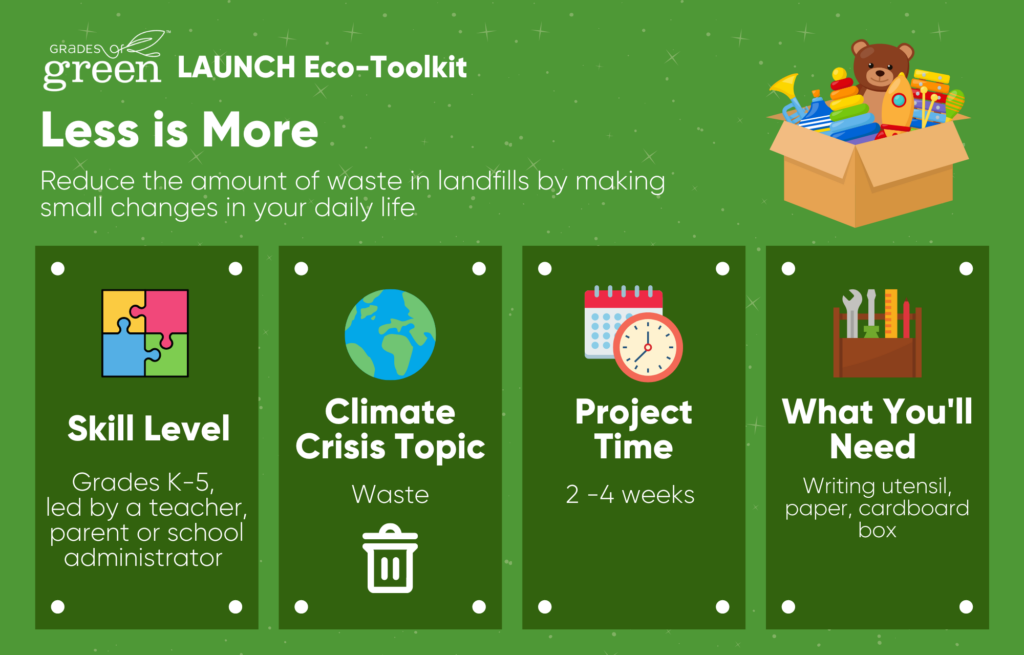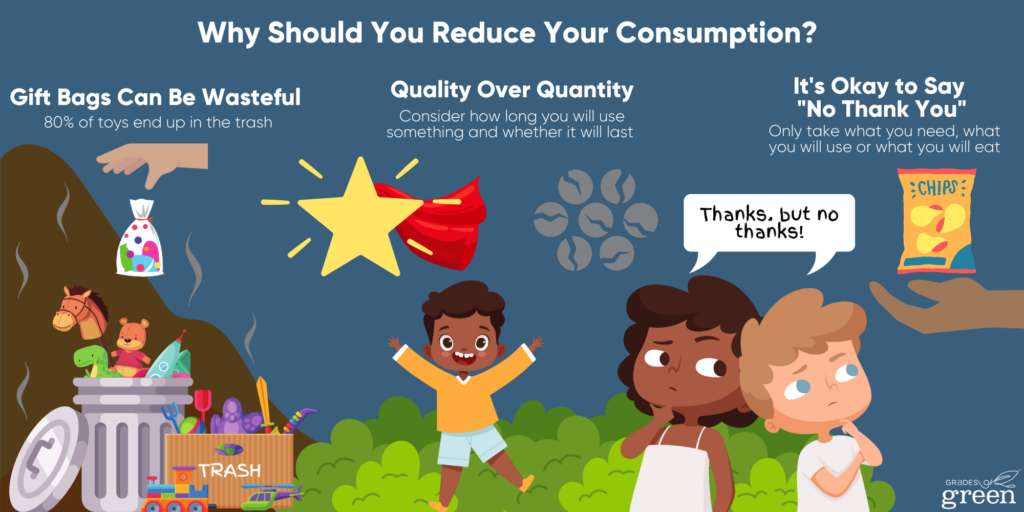Exchange the “quantity” of items for “quality” time!
You don’t have to have a big project to make a big impact. Sometimes the biggest impact we can have is the small changes we make in our daily lives. By prioritizing “quality” time over the “quantity” of items, we can reduce waste in landfills and have more fun with our friends too!
Created in partnership with Grades of Green Youth Leader, Bridie W.

Toolkit Details


NGSS
This toolkit address the following Science and Engineering Practices (SEPs) within the Performance Expectations of NGSS for Grades: K-2 and 3-5
- Asking Questions and Defining a Problem
- Planning and Carrying out Investigations
- Analyzing and Interpreting Data
- Using Mathematics and Computational Thinking
- Constructing Explanations and Designing Solutions
- Obtaining Evaluating, and Communicating Information
Learning Objectives
- Analysis
- Students will analyze their daily habits to see where they can reduce their waste, energy, and water usage.
- Project Management
- Students will keep track of how many resources they are saving.
- Students will practice leadership skills by delegating tasks to each other.
- Evaluation and Assessment
- Students will track and evaluate the impact of their project.
What is “Less is More?”
An important solution to help solve our world’s climate crisis is to reduce our intake of unsustainable items. With so many birthday parties and holidays, you may find yourself starting an entire collection of wasteful products made of plastic. Piling up toys, candy, and single use items causes something called overconsumption–overly consuming or collecting unnecessary things that hurt our environment.
What You Will Accomplish
Students will educate their classmates and or/family members on the impact of overconsumption. They will practice alternative ways to have fun through eco-friendly experiences and use their own creative action to reduce their collection of unsustainable products.
Educator Project Plan
Follow the steps below to set up a successful Less is More Campaign at your school! Need help? Contact us!
Track your metrics and submit your impact after implementing this toolkit. Your feedback helps keep our programs free for all across the globe.
Determine Participants
Use the Less is More Sign Up Sheet to have participants sign up.
- A Student Group such as (a club, before/after school program, non-school organization)
- A whole class
- The whole school
- Working with a small group of students? Plan to reduce party waste with your class!
- Working with a larger team? Build a campaign to educate your entire school on how you can have eco-friendly celebrations!
Why Should You Reduce Your Consumption
The resources provided below can be shown as a slideshow or printed out as individual worksheets for students to review.

Birthday Goody Bags Can be Wasteful
After many birthday celebrations, goody bags are given out. While all these little toys and candy may seem amazing at first sight, they are typically thrown out or break apart after just minutes of use. Approximately 80% of toys are tossed in the trash and since they are non-biodegradable, they don’t get recycled and end up in landfills. Remember, the 3 R’s (in order) are very important to help reduce this issue: reduce, reuse, and recycle! [1]
Quality Over Quantity
As our world keeps advancing with new, bigger, and “better” things, it’s hard not to want to keep up with all the latest toys and clothing trends you may spot around your community. Before you decide to get something, ask yourself this mindful question: Will I really use this item and if I do, how long will it last for? Hopefully, this can help guide you on what is a need and what is just a “want” that might break apart in a couple of days. Studies show that, in America, around 85% of all textiles (clothing materials) are thrown out. This shows us much of the stuff we collect is wasted and at the end of the day, they end up in landfills. When you find yourself deciding on an item, think about will you really use it or is it just something to add to your growing collection of things? Having quality experiences with friends and family such as going for a neighborhood walk, hike, or bike ride can reduce the want for more stuff while also improving health and saving money. [2]
It’s Okay to Say “No Thank You”
Sometimes it can be challenging to resist tempting prizes at fairs or say no to food put on our plate in the cafeteria, but both of these things contribute largely to overconsumption. In America, nearly 40% of all food is wasted. Here’s how we can help: politely saying “no thank you” when asked to take food that we know we will not eat or prizes that we see no use for is OKAY! While it seems hard at first, normalizing this will better our environment by reducing overconsumption and lessening waste produced by excessive food or plastic intake. [3]
Why Overconsumption is an Environmental Justice Issue
The overconsumption of resources typically occurs in the most affluent (higher income) communities and countries. However, these areas also have access to higher quality items and food, while lower income communities may not be able to afford “high quality” when it comes to toys, clothing, food, etc. leaving them with less sustainable options that are cheaper but tend to be more harmful for the planet. Not only do the affluent areas eat away at certain resources and damage our environment, but it takes away things from those who need it like low-income and newly industrialized countries. This injustice formed by overconsumption leaves areas critically low on supplies while other more high-income countries thrive with their amount of resources overflowing. [4]
Watch these Short Videos to Learn More on How to Reduce Your Consumption
Think About It!
Pre-Activity Questions
- What are some examples of overconsumption that you see at school, home, or in your community?
- What are the benefits of being mindful and reducing your collection of non eco-friendly products?
- What are some activities you can do without overconsuming?
Take Action: How to LAUNCH a Less is More Campaign
Lead students through the “Less is More” activity with guided instructions. Check out “Pro Tips” for additional help.
1. Get Organized
- Gain participants using the Less is More Sign Up Sheet
- Make it a challenge: ask your family, friends, or classmates to join your mission
2. Clean Up!
Find a cardboard box or another similar container. Look around your house for unneeded items that someone else could use and put them in the box.
Examples:
- Old Toys
- Books
- Clothes
3. Organize All Your Items
- Put all of your items that you don’t use anymore in assigned boxes
- Weigh the amount of items you gathered by putting the boxes on a scale. Use the Less is More Tracker to keep track of how much waste you reduced.
4. Research
- Practice your thinking skills & research somewhere in your community that could give these items homes!
- Use the Less is More Tracker to keep track of locations where you can donate these items.
- Here are some tips to help you find a location near you: Search for local community shelters, orphanages, places of worship and second hand stores that are accepting donations.
5. Give It a Home!
Drop off all of the boxes and give them to someone in your community that needs them.
Examples:
- Neighborhood church or temple,
- Yard give-away for neighbors,
- Ask a parent to post the boxes on your local “buy nothing” group,
- Your school or another school
Pat yourself on the back, you helped contribute to one of the 3 R’s: reusing!
6. Limit your screen-time
- Reduce the amount of time you are on devices, to reduce your electricity use! (ex: set time limits, only use on certain days, etc.)
- Find eco-friendly alternative activities that make you happy without the use of technology, such as going to the beach or the park.
7. Have “Quality” Fun
- Make fun memories and experiences without buying things or overconsuming!
- Practice the concept: Quality Time over Quantity of Items! Use the Less is More Tracker to record how many times you chose “quality” activities over “quantity.”
Call your local food bank or shelter ahead of time to see what items they need or what they are taking in.
Lookup recipes for holiday leftovers.
Reflection Questions
How’d It Go?
- What did you enjoy most about this project?
- What are some other ways you can help reduce overconsumption in your home or community?
- How would you talk to a friend or family number about this project?
- What personal changes will you make to reduce your impact on climate change?
Report Students’ Impact
Congratulations!! You’ve implemented Less is More! Don’t let all that hard work go unnoticed. Submit your results by clicking the green button below.
Project ongoing? No problem! Let us know what you’ve done so far.
By reporting your impact, Grades of Green can:
- CELEBRATE and elevate your students’ hard work and success.
- Offer our programs FREE for all students across the globe.
- AWARD stipends and certificates to hard-working educators and students.
Please take a few minutes to submit your results. Thank you!
Provided Resources
- Less is More Sign Up Sheet
- Less is More Tracker
- Less is More Wrap Form
- Less is More Presentation
- Toolkit Resources – Google Drive Folder
Congrats on completing the Less is More Eco-Toolkit!
Did you enjoy this toolkit? Find your next project here!